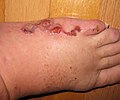Cutaneous larva migrans
| Cutaneous larva migrans | |
|---|---|
| Classification and external resources | |
 Typical "creeping eruption" associated with cutaneous larva migrans | |
| ICD-10 | Template:ICD10 |
| ICD-9 | Template:ICD9 |
| DiseasesDB | 3263 |
| MedlinePlus | 001454 |
| eMedicine | derm/91 Template:EMedicine2 |
| MeSH | D007815 |
Cutaneous larva migrans (abbreviated CLM) is a skin disease in humans, caused by the larvae of various nematode parasites of the hookworm family (Ancylostomatidae). The most common species causing this disease in the Americas is Ancylostoma braziliense. These parasites live in the intestines of dogs, cats and wild animals and should not be confused with other members of the hookworm family for which humans are definitive hosts, namely Ancylostoma duodenale and Necator americanus.
Colloquially called creeping eruption[1][2] due to its presentation, the disease is also somewhat ambiguously known as "ground itch" or (in some parts of the Southern USA) "sandworms", as the larvae like to live in sandy soil. Another vernacular name is plumber's itch. The medical term CLM literally means "wandering larvae in the skin".
Cause
[edit]Hookworm eggs are shed in infected dog (or other animal) feces to the ground, where they then develop over a period of 1–2 weeks into the infectious larval form (filariform larvae).[3] The filariform larvae can burrow through intact skin that comes into contact with soil or sand that is contaminated with feces. Although they are able to infect the deeper tissues of animals (through to the lungs and then the intestinal tract), humans are incidental hosts and the larvae are only able to penetrate the upper dermis of the skin[1] and thus create the typical wormlike burrows visible underneath the skin. These parasites apparently lack the collagenase enzymes required to penetrate through the basement membrane deeper into the skin.
Symptoms
[edit]The infection causes a red, intensely pruritic (itchy) eruption. The itching can become very painful and if scratched may allow a secondary bacterial infection to develop. Cutaneous larva migrans usually heals spontaneously over weeks to months and has been known to last as long as one year.[4] However, the severity of the symptoms usually causes those infected to seek medical treatment before spontaneous resolution occurs. Following proper treatment, migration of the larvae within the skin is halted and relief of the associated itching can occur in less than 48 hours (reported for thiabendazole).[1]
This is separate from the similar cutaneous larva currens which is caused by strongyloides. Larva currens is also a cause of migratory pruritic eruptions but is marked by 1) migratory speed on the order of inches per hour 2) perianal involvement due to autoinfection from stool and 3) a wide band of urticaria.[5]
Treatment and prevention
[edit]CLM can be treated in a number of different ways:
- Systemic (oral) agents include albendazole[1][2] (trade name Albenza)[6] and ivermectin[1] (trade name Stromectol)).[7]
- Another agent which can be applied either topically or taken by mouth is thiabendazole[1][2] (trade name Mintezol)),[8] an anti-helminthic. When taken orally, this medication is known to cause nausea. A topical preparation can be made by mixing the ground pills in vaseline. This mixture can be spread lightly on the lesion and held in place with a plaster. This produces local tissue levels sufficient to kill the parasite without the systemic side effects when taken orally.
- Topical freezing agents, such as ethylene chloride or liquid nitrogen,[1] applied locally can freeze and kill the larvae, but this method has a high failure rate due to the fact that the larvae are usually located away from the site of the visible skin trails. Additionally, this is a painful method which can cause blistering and/or ulceration of the skin and it is therefore not recommended.[1]
- It is recommended to use Benadryl or some anti-itch cream (i.e. Cortizone or Calamine lotion). This will help relieve some of the itch.
- Wearing shoes in areas where these parasites are known to be endemic offers protection from infection.[1] In general, avoiding exposure of skin to contaminated soil or sand offers the best protection. In some areas dogs have been banned from beaches in an attempt to control human infection.[1]
Additional images
[edit]See also
[edit]References
[edit]- ^ a b c d e f g h i j Caumes, E. (1 May 2000). "Treatment of Cutaneous Larva Migrans". Clinical Infectious Diseases. 30 (5): 811–814. doi:10.1086/313787.
- ^ a b c Albanese, G; Caterina Venturi; Giuseppe Galbiati (2001). "Treatment of larva migrans cutanea (creeping eruption): a comparison between albendazole and traditional therapy". International Journal of Dermatology. 40 (1): 67–71. doi:10.1046/j.1365-4362.2001.01103.x. PMID 11277961.
- ^ CDC. "Parasites". Retrieved 25 April 2013.
- ^ Chaudhry, AZ; Lonworth DL (1989). "Cutaneous manifestations of intestinal helminthic infections". Dermatol Clin. 7: 275–90.
- ^ ARTHUR, ROBERT P. (1 August 1958). "Larva Currens". A.M.A. Archives of Dermatology. 78 (2): 186–90. doi:10.1001/archderm.1958.01560080044007. PMID 13558704.
- ^ Drugs.com. "Albenza". Drugs.com. Retrieved 25 April 2013.
- ^ Drugs.com. "Stromectol". Drugs.com. Retrieved 25 April 2013.
- ^ Drugs.com. "Mintezol". Drugs.com. Retrieved 25 April 2013.


